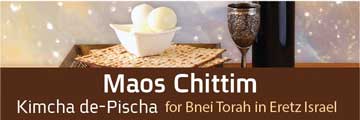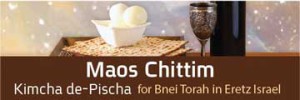How is it that an eiruv can be built in Yerushalayim, where there are many streets more than 16 amos wide, and for sure more than 600,000 people that live in the city (seemingly no matter how you define a reshus harabim, according to the pesak of Shulchan Aruch there will come out a problem). Many Batei Dinim were nonetheless able to build an eiruv in Yerushalayim, and the rabim l’maseh do rely on it (including many Rabbanim and Talmidei Chochamim)?
Answer:
The opinion on whom some rely defines a public domain as a road on which 600,000 travel on a given day. The road then becomes a Torah-mandated public domain.
Although there are 600,000 residents in Jerusalem, there are not 600,000 who travel through any road within the eiruv, which is why many are lenient to use the eiruv. As for the Jerusalem-Tel Aviv highway, some cite the Beis Efraim, who writes that people in a car (he refers to a carriage) can only be counted as one.
Note that the Biur Halachah cites a list of rishonim who hold both ways (whether 600,000 is a requirement for reshus harabim or not), and writes that “one cannot object to those who are lenient” (though he doesn’t recommend it).
The Chazon Ish (107:5) has another reason for which there is no reshus harabim in most in-town circumstances.
Many, however, are indeed stringent, and rely only on local, smaller eiruvin, where there is no concern of 600,000 people, and often no concern of a road 16 amos wide. The Batei Din that you note and various rabbis have generally endorsed the smaller eiruvin which close off a section or neighborhood, and not the entire city (and certainly not the Jerusalem-Tel Aviv highway).











Who holds the opinion that the 600,000 is only having to do with a particular road that people travel on and not the whole city?
Where is the Beis Ephraim?
In many areas of Yerushalayim (even “smaller areas”) where one will find a smaller Eiruv built by a Beis Din one will also find roads that are 16 amos wide (take for example Kiryat Sanz/Kiryat Belz area and around there. Certainly you have streets that are 16 amos wide and built there are the smaller Eiruvin (granted though many other parts of the city don’t have this problem of 16 amos.) However Rechov Bar Ilan/Yermiyahu would also be a problem and is in the “middle” of the charedi neighborhood.
In any case the source of the 600,000 on one road and the Beis Ephraim would be greatly appreciated. Thank you.
Concerning the roads, see Iggros Moshe, Orach Chaim 1:139, and a number of other places (noted in a comment from J.)
I don’t have the source of the Beis Efraim next to me, but it can probably be easily found by means of a search.
It should be noted that the MB was relying on the Mishkenos Yaakov’s list of rishonim, which, as R. Mendel Kasher argued has now been superseded, such that we now know that the overwhelming majority of rishonim do require shishim ribo to classify an area as a reshus harabbim. See here for more details: http://eruvonline.blogspot.co.uk/2006/01/overwhelming-majority-of-rishonim.html
Furthermore, as several poskim note (Toldos Shmuel, 3:81:7, 3:86:8; Bais Av, 2:5:2; Divrei Yatziv, 2:173:1, and Even Yisrael, 8:36), the MB did not have access to the Beis Efraim, as the Chofetz Chaim wrote himself ((Bi’ur Halachah, 208:9, s.v. Eino Mevarech), and the accepted halacha is not like the MB on this issue.
One further reason to allow an eruv in Jerusalem are that its streets are not mefulashim mishaar l’shaar. Furthermore, many of the eruvin are built mostly of mechitzos that are omed merubah al haparutz and this creates a reshus hayachid m’deoraysa. See the following teshuva in Shevet Halevi (authored by Rav Shmuel Vozner’s son) for more details on both of these issues:
http://hebrewbooks.org/pdfpager.aspx?req=1418&st=&pgnum=166
It should also be noted that according to many poskim (including R. Moshe Feinstein), for an intercity road (seratya) to pose a problem due to it being a reshus harabbim, one needs to have 600,000 traversing that particular stretch of road (See Igros Moshe, O.C. 1:139:5, 4:87, 5:28:16), which is not the case with Jerusalem.
Thanks very much for the extra sources and points.
Thanks for the answers. As I am a bit involved in a planned Eruv in Hampstead in London, could you elaborate on one of your answers, namely ” many of the eruvin are built mostly of mechitzos that are omed merubah al haparutz and this creates a reshus hayachid m’deoraysa.” If we hold that 600,000 inhabitants make a city into a Reshut Harabim d’Oraita, (i.e. not following Rashi who introduced Drissat Haregel,) then how can making smaller sub-area Eruvim beak up this large single Reshut Harabim into smaller Chazeirot?
Secondly, to assist my understanding, is Mefulashim m’shaar l’shaar the primary consideration, with 600,000 an additional possible requirement, or is 600,000 on its own anough to create a Reshut Harabim. Certainly London has no roads which are Mefulashim. Thanks
Jul
Thank you J.!
First of all, many thanks to the esteemed rabbonim of Dinonline for enabling this discussion.
Yehoshua – See this article (which appeared in the journal Or Yisroel) (note 16) for details of the Beis Efraim’s opinion:
http://hebrewbooks.org/pdfpager.aspx?req=13626&st=&pgnum=237
See also this article, from the same journal, for further discussion of the Beis Efraim:
http://hebrewbooks.org/pdfpager.aspx?req=13599&st=&pgnum=273
J. – Thanks for the additional sources. I’d like to continue this discussion. Please email me
[email protected]
Thank tou!
Leave a comment